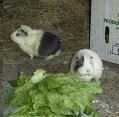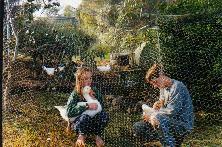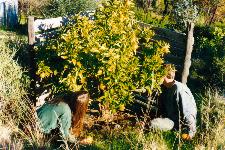 |
Bungala Ridge Permaculture Gardens REDUCE ... REUSE ... RECYCLE ... REPAIR ... RETURN ... REVEGETATE ... REPLENISH |
||||||||
|
|||||||||
|
|
What is Permaculture? Some Definitions In 1978 by Bill Mollison, an Australian ecologist, and one of his students, David Holmgren coined the word "permaculture". It describes a process for designing sustainable food production systems and ecologically-sensitive human communities. The aim of permaculture is the harmonious integration of human dwellings, micro-climate, annual and perennial plants, animals, soils, and water into stable, energy efficient, productive communities. Permaculture design focuses on building relationships between these elements by observing and copying patterns found in nature. Permaculture design concepts are applicable to urban and rural settings; single households, whole farms and towns. "Integrated farming" and "ecological engineering" are terms sometimes used to describe perma-culture, however these terms alone do not capture the holistic nature of permaculture. We've used permaculture to help us devise learning programs for our children's home education. Over the years this has led us to adopt a natural style of learning that is efficient and, we think, successful. Permaculture is copyright word, owned as a common copyright by the Permaculture Institutes & their graduates. Permaculture is the study of integrated systems for the purpose of better design and application of such systems within sustainable human society. Permaculture is of necessity a small scale, labour efficient endeavour, but with far reaching implications and effects. The connections and relationships between all elements within the design is kept uppermost in the mind, as well as a thoughtful consideration of the intrinsic characteristics of those elements. A core principle of permaculture is that each component in a system performs multiple functions, and each function is supported by many elements. "Permaculture is a philosophy of working with, rather than against nature; of protracted & thoughtful observation rather than protracted & thoughtless labour; & of looking at plants & animals in all their functions, rather than treating any area as a single-product system."
Permaculture is built upon an ethic of caring for the earth and interacting with the environment in mutually beneficial ways.
Permaculture is a holistic approach to landscape design and human culture. It is an attempt to integrate several disciplines, including biology, ecology, geography, agriculture, architecture, appropriate technology, gardening and community building.
Permaculture is a way of life which shows us how to make the most of our resources by minimizing waste and maximizing potential. Living ecologically doesn't mean giving everything up, but relearning the value of nature & understanding new ways of being wealthy.
It is a synthesis of ecology and geography, of observation and design.
It is the harmonious integration of landscape and people providing their food, energy, shelter and other material and non-material needs in a sustainable way. The practice and development of liberating mental, emotional and spiritual ways of being.
It seeks to provide a sustainable and secure place for living things on this earth.
Permaculture can be as small as a window with sprouts or as large as a farm or a bioregion. It can be in the city, the suburbs or in the country. Permaculture addresses the way we live on this planet in a graceful and healthy way, respecting the plants and animals around us, and leaving the biosphere in a more productive and healthy state than we found it.
Permaculture is a world-wide movement of designers, teachers, & grassroots activists working to restore damaged ecosystems & human communities. Permaculture derives practical techniques & principles from the study of natural systems & applies them to earth repair & care.
It empowers the individual to be resourceful, self-reliant & a conscious part of the solution to the many problems facing us, both locally & globally.
Permaculture is not an end or destination, but rather a means or road leading towards sustainable & ecologically sound ways to meet human needs.
Applied on a larger scale, we could create abundance everywhere in the world. All we need is human intelligence, courage, & insight.
Permaculture combines current technology with aboriginal cultural knowledge collected over generations: to create self-contained, self perpetuating ecological systems. Return to What is Permaculture
|
Hot Links!
This site is sponsored by
|
|||||||
|
|
|
|
|||||||














